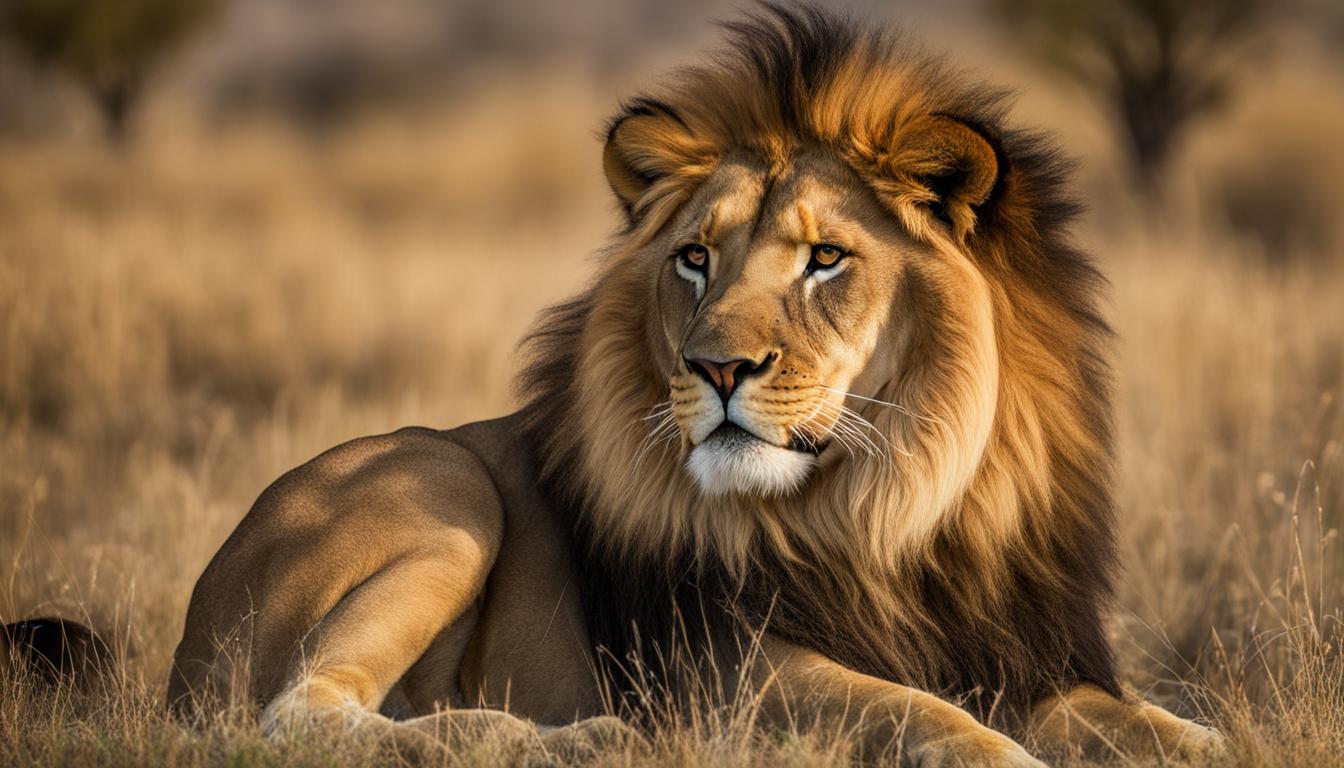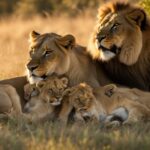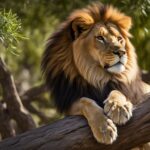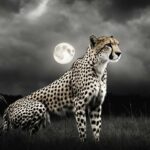Lions, the fierce cats of the genus Panthera, are native to Africa and India. While they have no natural predators in the wild, they do have some natural enemies that threaten their survival. Apart from humans, lions face predation from hyenas, buffalos, crocodiles, porcupines, and baboons.
Key Takeaways:
- Lions have no natural predators in the wild.
- Hyenas, buffalos, crocodiles, porcupines, and baboons are natural enemies of lions.
- Hyenas are known to attack and kill lion cubs and weak adult lions.
- Buffalos are capable of taking down lions due to their size and strength.
- Crocodiles ambush lions underwater, especially when they are exhausted and drinking.
Hyenas – Natural Enemies of Lions
When it comes to the natural predators of lions, hyenas are often at the top of the list. These cunning creatures are known for their scavenging nature, but they are also skilled hunters. While they may not be able to take down adult lions easily, they pose a significant threat to lion cubs or weak and sickly adult lions. Hyenas use their pack mentality and strategic teamwork to overpower their prey, making them formidable adversaries for lions.
Unlike lions, hyenas are opportunistic predators, relying on their intelligence and adaptability to survive. They have powerful jaws that can crush bones, which allows them to consume almost the entire carcass of their prey. This ability makes them fierce competitors for food, often leading to clashes with lions. Despite their scavenging habits, hyenas are not afraid to engage in direct confrontations with lions, especially when it comes to protecting their territories or securing their own food sources.
While adult lions are difficult for hyenas to take down, lion cubs are more vulnerable. Hyenas are known to attack and kill lion cubs, eliminating potential future competitors. However, adult lions are capable of defending themselves against hyenas, thanks to their strength and size. With their powerful muscles and sharp claws, lions can fend off hyenas, making it challenging for hyenas to successfully prey on them.
Hyenas – Natural Enemies of Lions
| Hyena Characteristics | Impact on Lions |
|---|---|
| Scavengers and hunters | Pose a threat to lion cubs or weak and sickly adult lions |
| Pack mentality | Use strategic teamwork to overpower their prey |
| Powerful jaws | Can crush bones and consume almost the entire carcass |
| Engage in direct confrontations | Compete with lions for territories and food sources |
While the lion is often seen as the king of the animal kingdom, it is clear that there are natural enemies that can threaten its survival. Hyenas, with their scavenging and hunting abilities, pose a significant risk to lion cubs or weak adult lions. However, adult lions, with their strength and size, can fend off hyenas and protect themselves. The predator-prey dynamics between lions and hyenas highlight the complex interactions within the natural world.
Lions and Their Powerful Adversaries in the Food Chain
When it comes to the natural predators of lions, the buffalo stands out as a formidable adversary in the African savannah. With its massive size and impressive strength, the buffalo poses a significant threat to the king of the jungle. In fact, the buffalo has a 100% chance of winning in a one-on-one battle with a lion. This puts lions at a disadvantage when facing these powerful herbivores in their quest for survival.
To fully understand the dynamics of the lion food chain, let’s take a closer look at the physical attributes of the buffalo. With its sturdy build and sharp horns, the buffalo is perfectly equipped to defend itself against lion attacks. When a lion attempts to bring down a buffalo, it risks being gored or trampled by the powerful hooves. The sheer strength and resilience of the buffalo make it a force to be reckoned with in the African wilderness.
To illustrate the power dynamics between lions and buffalos, let’s examine the following table:
| Lion | Buffalo |
|---|---|
| Top predator in the food chain | Powerful herbivore |
| Relies on hunting for food | Feeds on grass and vegetation |
| Strength and agility as its main weapons | Size and physicality as its main defense |
| Threatened by a herd approach | Strength in numbers |
As shown in the table, the lion relies on its hunting prowess to secure food, while the buffalo derives its strength from its size and the protection of its herd. The clash between these two formidable creatures highlights the intricate balance of power and survival in the animal kingdom.
In conclusion, the buffalo is one of the most significant natural enemies of lions in their quest for survival. Its massive size, strength, and ability to defend itself make it a powerful adversary in the lion’s food chain. Understanding the dynamics between lions and their adversaries offers valuable insights into the delicate balance of nature and the struggle for survival in the animal kingdom.
Crocodile – The Ambush Attacker of Lions
In the vast wilderness of Africa, lions face numerous natural enemies that constantly threaten their existence. One such formidable predator is the crocodile, an aquatic reptile known for its stealth and lethal ambush attacks.
Crocodiles patiently lie in wait beneath the surface of the water, lurking in rivers, lakes, or watering holes where lions often come to drink or cool down. With their powerful jaws and sharp teeth, they can deliver a swift and deadly strike, catching the unsuspecting lions off guard.
This ambush hunting strategy gives crocodiles a significant advantage over the mighty lions, which are at their most vulnerable state when quenching their thirst. While lions are strong and fierce on land, their agility and combat prowess become limited when navigating through water. The crocodile’s stealth and surprise attack tactics make it a true menace to the kings and queens of the savannah.
The Lethal Encounter: Crocodile vs Lion
A confrontation between a crocodile and a lion is both a terrifying and awe-inspiring sight to witness. The raw power of these apex predators is on full display, as they engage in a deadly duel for survival. In such encounters, the outcome heavily depends on the element of surprise and the strength of each opponent.
While the crocodile has the advantage underwater, its terrestrial mobility is limited. On the other hand, lions dominate the land with their speed, strength, and sharp hunting instincts. To survive an attack from a crocodile, the lion must rely on its agility and evasive maneuvers, attempting to avoid becoming trapped in the crocodile’s vice-like grip.
However, these encounters are seldom witnessed, as lions have developed a strong sense of caution towards bodies of water that hide these lurking predators. Nevertheless, the occasional clash between these two iconic creatures showcases the incredible dynamics and challenges of life in the African wilderness.
The Circle of Life: Survival in the Wild
The crocodile’s ability to ambush and overpower lions is a testament to the intricate web of predator-prey relationships in nature. It reminds us that even the mightiest of beings have adversaries capable of challenging their reign in the animal kingdom.
So, the next time you venture into the African plains or witness a wildlife documentary, ponder the incredible adaptability and resilience of these magnificent creatures. From the ambush attacks of crocodiles to the strategic hunting of lions, every predator and prey plays a crucial role in maintaining the delicate balance of the natural world.
| Crocodile | Lion |
|---|---|
| Ambush predator | Apex predator |
| Strong jaws and sharp teeth | Powerful claws and sharp teeth |
| Preys on lions near water sources | Hunts various prey species |
| Advantageous in aquatic environments | Agile and swift on land |
Porcupine and Baboon – Surprising Predators of Lions
In addition to the more commonly known predators such as hyenas, buffalos, and crocodiles, lions also face the unexpected threats of porcupines and baboons. Despite their size, these seemingly harmless creatures have been known to engage in formidable battles with lions, showcasing the intricate predator-prey relationships in the natural world.
The porcupine, armed with sharp quills, poses a surprising danger to lions, leopards, and even hyenas. Its quills have the ability to penetrate vital organs, making it a formidable adversary. While encounters between porcupines and lions are relatively rare, these spiky creatures have proven that size is not always an indication of strength.
On the other hand, baboons, known for their intelligence and cunning, exhibit a different approach to preying upon lions. These resourceful primates often steal lion cubs, causing distress to the lion pride. Moreover, in some instances, they have been known to kill the cubs during these confrontations. Such behavior highlights the complex dynamics of predator-prey relationships in the animal kingdom.
Understanding the various natural enemies of lions is crucial to comprehending the delicate balance of the ecosystem. These surprising predators, the porcupine and baboon, demonstrate that even in the animal kingdom, survival is not solely determined by strength and size, but also by cunning strategies and unexpected abilities.
FAQ
Are there any natural predators of lions, apart from humans?
Yes, apart from humans, lions have natural enemies that threaten their survival.
How are hyenas a natural enemy of lions?
Hyenas are known to attack and kill lion cubs or weak and sickly adult lions.
Can buffalo take down lions?
Yes, with their massive size and strength, buffalo are capable of killing lions and other animals that pose a threat to them.
Do crocodiles attack lions?
Yes, crocodiles are capable of launching surprise attacks on lions when they are drinking from shallow water.
Can porcupines and baboons kill lions?
Yes, porcupines can kill lions, leopards, and hyenas using their sharp quills. Baboons often steal lion cubs and kill them in the process.







